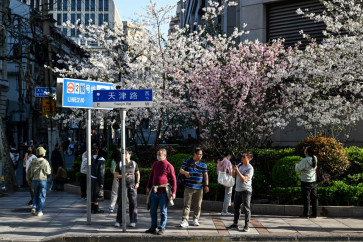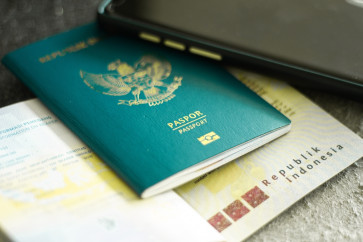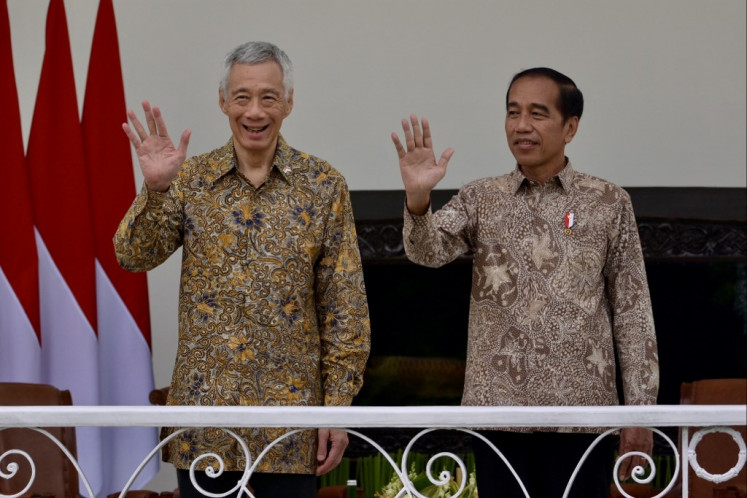Simeulue marine conservation zone a collaborative community project
Ready for market: A worker shows a lobster that was raised in a keramba and is ready to be sent to market
Change Size

Ready for market: A worker shows a lobster that was raised in a keramba and is ready to be sent to market.
Local communities on Simeulue Island are reaping economic benefits while maintaining sustainability with their participation in managing a marine conservation zone in Aceh province.
The Marine Conservation Zone of Siumat Island, Air Pinang Village and Simanaha Island (PISISI) in Simeulue regency off the west coast of Aceh province is managed in collaboration with local communities, so it is only fitting that they get some benefit from this collaborative effort, while the zone may become a national model of sea management.
Dozens of children go to fish in the sea at Sinabang, the port of and administrative seat of Simeulue regency, by using simple equipment such as fishing rods, spears and nets, although they mostly rely on their hands to gather mollusks from the shallow waters.
There are also several floating cages known as keramba for fish or shrimp breeding, watched over by local youths who, mostly being students, rush to the cages after school to prevent poaching.
Fajar, one of the children who fishes at Sinabang, said he and his peers had never been forced by their parents into working. 'While some of it is eaten, the rest like sea slugs are sold. The income can pay for school,' added Fajar.
Over a dozen miles north of Sinabang lies Siumat Island. Muslian, 42, was diving with fishing equipment to catch octopuses. Many of the youngsters were leaving the Siumat quay as the tide was rising. After a while, Muslian appeared with three octopuses. 
He said his catch was a good source of protein and nutrients for children's growth. 'But I only dive twice to three times weekly for octopuses. I spend a lot more time catching various types of fish that can be sold for high prices,' said Muslian.
Muslian frequently encounters turtles, but he has never caught them as they are protected animals, as is the case with sharks and rays. 'If these species are continuously hunted, the ecosystem's equilibrium will be affected,' he pointed out.
'Sharks are a main predator in the marine food chain. If the predator is gone, the result will be an imbalance in the population of marine animals,' added Muslian.
Several kilometers southwest of Sinabang, Agus, 28, was lifting a net from a floating cage. Inside the cage were dozens of lobsters of different types, with their long limbs thrashing about.
Since 2008, Agus has taken care of floating lobster cages owned by Susi Pudjiastuti, now better known as the minister of maritime affairs and fisheries. According to Agus, Teluk Dalam district is a strategic location for lobster breeding.
Lobsters are suited to less turbulent waters so that the district's calm sea suits the crustaceans, enabling them to grow optimally. The company also employs him to obtain lobsters from fishermen, but their supply is seasonally dependent. 
Therefore, Agus only accepts lobsters weighing above 210 grams from fishermen. He doesn't accept spawning female lobsters either. 'We're committed to conserve lobsters found in nature. Such restrictions will make fishermen understand that marine resources are not to be endlessly exploited,' said Agus.
Teluk Dalam Sea Commandant Teuku M. Nasir confirmed that his area was part of the collaborative management zone of PISISI. The Simeulue regency administration in 2006 reserved 46,735.03 hectares for PISISI, covering waters in three districts: Teluk Dalam, East Simeulue and South Teupah.
'There is a joint commitment that this zone remains part of local communities' daily activities. With the conservation zone status, locals needn't be afraid of being evicted because PISISI is collaboratively managed,' stressed Nasir.
Fishermen are allowed to benefit from marine products by using environment-friendly practices. Local people have the right to prohibit people fishing with trawlers, bombs, potassium and cyanide. If violators ignore the ban, fishermen usually report them to the authorities.
There is still a lot of work to do to meet the national target of 20 million hectares of sea conservation zones in 2020, but the PISISI conservation zone in Simeulue can be a cornerstone of the national project.
Air Pinang Sea Commandant Asmanja said that it was still necessary for regular patrols to be conducted to violations. 'We cooperate with the Siumat Island sea commandant's personnel in order to enhance the effectiveness of the operation. The more vigilant we are in our patrols, the more impact we will have on the security of the zone,' he said.
Maritime Affairs and Fisheries Office Simeulue head Gusni emphasized that the protection of resources inside the conservation zone provided both ecological and economic benefits.
The PISISI zone, according to him, is collaboratively managed and does not depend solely on government funding. The full participation of various parties is expected to make this zone a national model in pursuing the 2020 sea conservation target.
The conservation zone has the potential to have positive effects in diverse fields such as tourism, catching fishery and aquaculture fishery, pursuant to the Aceh Provincial Bylaw No. 19/2013 on the Aceh spatial layout plan for 2013'2033.
'The bylaw mandates 211,208 hectares of marine conservation zones over the entire region of Aceh. That's why we need the cooperation of all parties,' revealed Gusni.
Senior marine officer of Fauna & Flora International (FFI), Rakhmat Dirgantara, said that the FFI had an important role in strengthening the management and conservation of the marine zone by involving sea commandants. 'We refer to the zone as an LMMA, a Local Marine Managed Area,' said Rakhmat.
In Aceh, there are 44 LMMAs, including the PISISI. 'The management of the zone's marine resources is oriented to utilize local wisdom, covering local culture, customs, social life and innovations already existing long before the introduction of government policy,' he continued.
In practice, added Rakhmat, the conservation zone's socio-economic management should take account of the benefits for the local community, with no other choice but to involve local people who had been living in the area for a long time.
In reality, local fishermen have safeguarded their waters against threats and have never used fishing methods that have harmed the ecosystem. They are the ones who have guarded these waters for decades for decades and perhaps even centuries.

' Photos by Syafrizaldi









